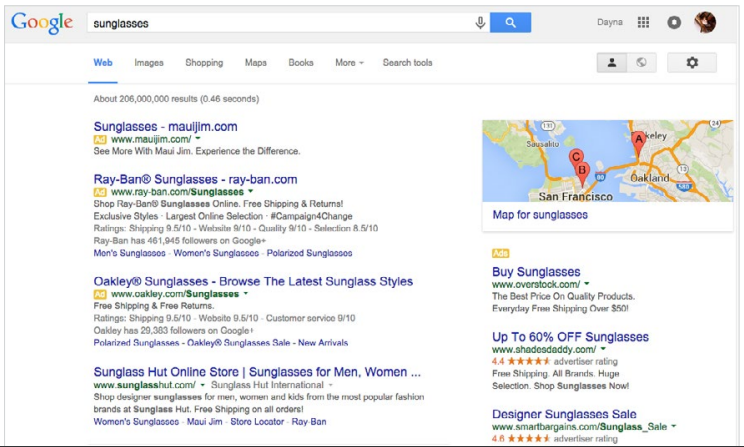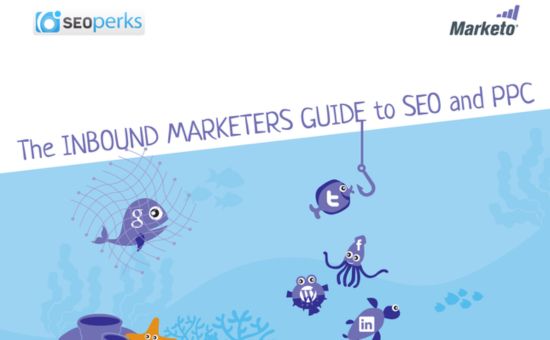Types of Digital Ads: PPC Search, Display, and Social | Adobe Experience Cloud
Pay-Per-Click (PPC) Advertising
PAY-PER-CLICK (PPC) SEARCH ADS
With pay-per-click (PPC) search ads, your ad appears as a “sponsored result” at the top or side of search engine results, and you pay for each click it receives. PPC ads can be customized to show when specific search terms are used, allowing for highly targeted advertising.
For many businesses, PPC ads represent a significant portion of their advertising budget. In fact, a report by the Interactive Advertising Bureau revealed that in 2014, search ads made up $9.1 billion, or 39%, of total online ad revenue.
Pay-Per-Click (PPC) Search Ads
PPC ads are versatile, highly visible, and effective across various industries. They are also considered contextual ads—appearing when users search for specific keywords or phrases.
For instance, if you search for “sunglasses,” you’ll see PPC ads displayed at the top and on the right side of the Google search results page.

PPC Keywords
When developing your PPC strategy, start by identifying the keywords you want to rank for and then create and optimize ads for those terms. This ensures that when someone searches for those keywords, your ad is more likely to appear.
Choose keywords based on:
- Relevant business objectives
- Traffic potential
- Level of competition
Keyword Research
To identify suitable keywords, use tools like Google AdWords Keyword Planner to find core and related search terms. When evaluating and selecting keywords, consider the following:
- Is the keyword relevant to my website, product, service, and content?
- If someone searches for this keyword, will they find my offerings valuable?
- Do we have existing content for this keyword, or do we need to create new content?
- Will traffic from this keyword generate new business for our company?
It’s beneficial to conduct a keyword brainstorming session with your team and key stakeholders, including executives from different areas of the business. After brainstorming, you should have a comprehensive list of keywords, ranging from 10 to hundreds, depending on your objectives.
Additionally, distinguish between early and late-stage keywords. Ensure that your offers and ad copy align with buyers at the right stage in their purchasing journey.
After selecting your keywords, take some time to review the ads your competitors are running. The more ads you see, the more competitive the keyword is, which can increase the cost of your ads and make it harder to stand out.
For example, when searching for “running shoes,” you’ll find ads from several companies, including Road Runner Sports, Zappos, and ASICS.
Keyword Search for “Running Shoes”
Google displays two types of ads for this keyword: text-based PPC ads that appear in the search results and Product Listing Ads from Google Shopping. Product Listing Ads showcase images and details of products from various retailers online.
PPC Ad Copy
Creating a successful PPC ad requires compelling copy and an engaging headline, but you only have 25 characters for the headline and 70 for the copy, so you must be concise and impactful.
According to Search Engine Watch, here are five golden rules for writing PPC ads:
- Use clear, simple language.
- Incorporate vivid and emotional words.
- Focus on keywords and their intent.
- Include a compelling offer and a strong call-to-action (CTA).
- Avoid overusing abbreviations or short phrases.
Relevancy
To engage your audience, your copy should directly address their pain points or needs, making the value of clicking your ad immediately apparent. For instance, in an ASICS ad for running shoes, the headline “Go Run It” is action-oriented, while the ad states, “Find the running footwear for your training needs,” encouraging immediate clicks.
PPC Headlines
PPC headlines need to grab attention quickly. Don’t hesitate to use strong language to create urgency and convey authority. Review competitor ads for your keywords to ensure your headline stands out in the crowded space.
Call-to-Action Strategy
PPC ads are excellent for promoting content and products, but remember that users searching for your keywords may not be familiar with your brand. Therefore, it’s often better for your CTA to offer valuable content rather than a direct sales pitch. For example, a LinkedIn ad for “social selling” offers a guide on the topic, along with statistics that emphasize its importance. This approach educates the audience rather than promoting the product directly.
Ad Extensions
Enhance your PPC ads using ad extensions such as:
- Sitelink extensions
- Location extensions
- Call extensions
- App extensions
- Review extensions
- Callout extensions
For instance, a PPC ad from ShoeDazzle includes site link extensions, visible as blue text below the main ad, providing additional navigation options for users.

Unlock expert strategies for digital ads. Continue reading and download the guide now!
Related guide: The Inbound Marketers Guide to SEO and PPC | Adobe Experience Cloud
- TYPES OF DIGITAL ADS: PPC SEARCH, DISPLAY, AND SOCIAL
- PAY-PER-CLICK (PPC) SEARCH ADS
- DISPLAY ADVERTISING
- SOCIAL ADVERTISING
Number of Pages:
- 32 pages
Pricing:
- Free






